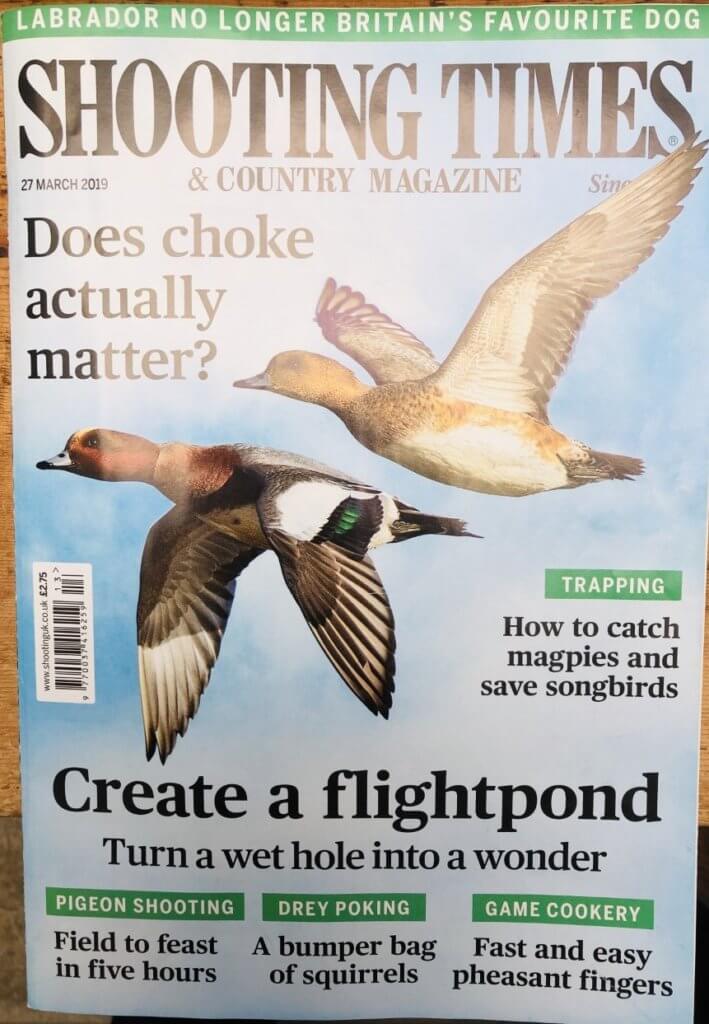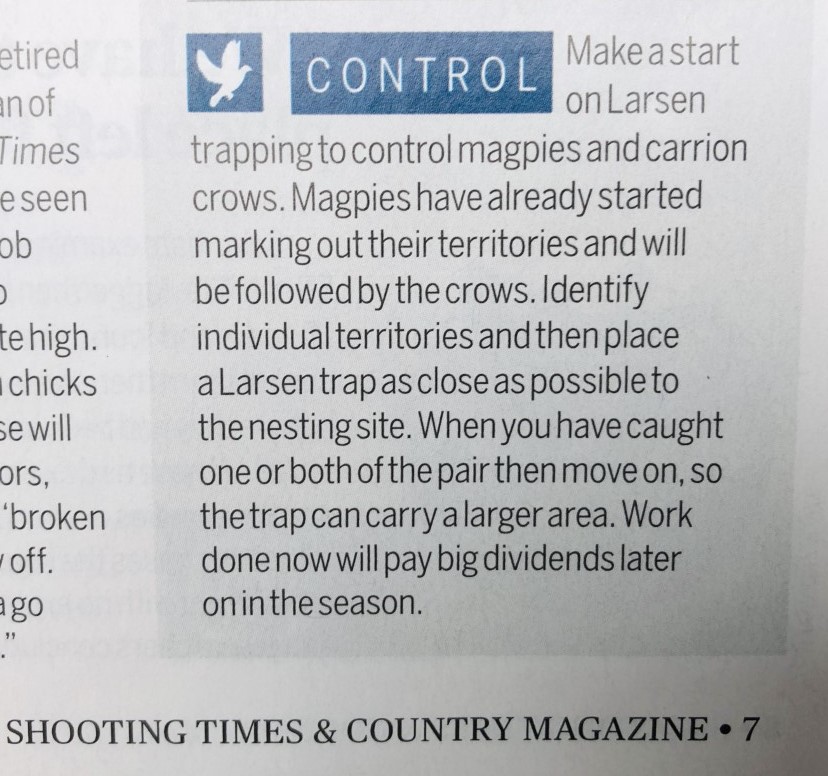
Wild Justice’s fully-funded legal challenge of the General Licences features on pages 6 and 7 of this week’s Shooting Times.
The piece isn’t too bad (although it does contain errors) but notably, as in a piece in Farmers Weekly, neither team of journalists (!) has managed to get a quote from Natural England or Defra on the subject – perhaps because they don’t know what they are going to do?
We are yet to see ‘Wild Justice is wrong and we are going to fight them all the way in the courts’ nor have we yet seen Natural England say ‘It’s a fair cop, we hoped no-one would notice but now they have I guess we’ll have to do our jobs properly’.
Shooting Times though is full of evidence, which indeed may end up in court as evidence, of the way the General Licences ‘work’ in practice and how they are mis interpreted by the shooting community.
See that the cover of ST talks about catching magpies and saving songbirds although there is no decent evidence that Magpies have a population level impact on the numbers of any songbird (I could quote the references). This is casual and unscientific killing.

The above, at the bottom right hand corner of page 7 appears to bear little relation to the terms and conditions of the General Licences in encouraging what appears to be widespread killing of a couple of bird species for no particular reason…
The Shooting Times‘s editor Patrick Galbraith tells a tale of heading off to Essex for a spot of pigeon shooting – he doesn’t seem to have shot many but he had a nice Bakewell tart. He was using decoys to entice the pigeons into range but he doesn’t mention the serious agricultural damage that I assume he was hoping to reduce.
On page 42 the GWCT’s Dr Mike Swan tells us all how to operate a Larsen trap (and to sign up for a GWCT course if we’d like more information) and, maybe because of Wild Justice’s legal challenge, refers us all to the conditions of the General Licences without saying what they are. The article refers to gamekeepers as people who use Larsen traps but doesn’t mention why gamekeepers use them. Funny that. Is it to increase songbird numbers (if so, the GWCT know there is little evidence for success in that regard) or is it to protect non-native Pheasants and Red-legged Partridges? The closest the article comes to coming clean on this is ‘When run properly, they [Larsen traps] remove an annual ‘harvest’ of crows and magpies, allowing our game – and a range of other birds from curlews to song thrushes – to be more productive‘. [Note the absence of any claim about population levels].
Then there is a piece about shooting pigeons or ‘the Wessex hedge grouse’ to provide a sumptuous meal. I like the occasional pigeon myself but I’m not sure where the law states that you can shoot pigeons for fun or food at the moment and so far no-one has enlightened me.
And there is an article, quite interesting I thought, about shooting pigeons in Lincolnshire although it does read like an article about the fun of shooting rather than the need for shooting. Bird scarers are conspicuously missing from the photographs.
It’s almost as if the General Licences exist to provide copy for the Shooting Times in the closed season for those species deemed, or should that be doomed (?), as quarry species.
I noticed this strange note in Shooting Times too – apparently it is the official weekly journal of BASC and the Clay Pigeon Shooting Association. Well, I didn’t know that. And I don’t know what it means either. I’ll have to ask.

From another IMHO rubbish magazine: Countryman’s Weekly
RETURN OF THE WELSH GROUSE
By Joe Dimbleby.
“DAVID Thomas is a gamekeeper on Beacon Hill moor, 5,000 acres of the Crown Estate near Pilleth in Powys and the site of Owain Glyndwr’s famous defeat of the English at the battle of Bryn Glas. The land is grazed by sheep farmers who hold commons’ rights and the shooting rights are rented by a local syndicate captained by Peter Hood, a retired hill farmer. David’s post is funded by the Welsh Government as part of the Powys Moorland Partnership which includes three separate moors aiming to restore grouse and other endangered moorland birds.”
It’s the gamekeeper’s wages being “funded by the Welsh Government” that amazes & horrifies me and goes on to detail the trapping, snaring and moorland burning. What would Iolo say? Or have they mis-reported all this to make it seem the Welsh Govt are backing DGS?
I do plenty of talks about encouraging wildlife in your garden for the BTO’s Garden Birdwatch scheme. Invariably someone comes up with sparrowhawks and magpies as being a principle cause of the decline of song birds. I always point out that I have successfully breeding goldcrests, wrens, chaffinches, goldfinches, greenfinches, dunnocks, wrens and blackbirds in my garden and its surrounds (I know, because I ring their fledged young every year) and I have successfully breeding magpies, jackdaws and carrion crows regularly visiting my garden.
Nice front cover pic – pity such a super species is a legitimate quarry species.
I remember whne the Larsen Trap first arrived in Britain, promoted as the next big thing and the solution to all our corvid problems. ( I was a part-time keeper in those days, on a shoot run for locals on a budget, rather than “toffs with dosh”). Apart from a general sense that corvids were not quite the problem on our shoot some others seemed to think ,it soon became apparent that Larsen’s would not solve our problems as being part-time meant that they could not be monitored effectively and humanely. But lots of other people used them , probably for 30 odd years, and guess what, there are probably more Magpies about now than they were then!! All that Larsen trapping ( some of it maliciously recreational by householders, even little old ladies) has clearly not affected the population much!!
I too like to occasionally eat pigeon, although its difficult to nigh on impossible to justify shooting them locally here in mid Wales, coupled with the fact I’ve not owned a shotgun for nearly fifty years. The killing of territorial corvids can in most circumstances increase the problem ( as it does with Mink and probably most things) not reduce it. Take out the local territorials and all those members of that species locally that want a territory move in, to dispute over ownership, at higher density than the original pair. Most predator control is largely pointless in general terms, unless that predators numbers are severely reduced over large areas. How do keepers justify crow control when most of them a reliant on released pheasants and partridges, whose numbers are not affected by corvids. I once heard a young keen ( but foolish) keeper say all crows must be controlled because “all black birds are evil.” I like corvids, yes they have some bad habits but so do most people! The general licence gives the ignorant unfettered belief they can kill all the things on the list they do not like without the need for justification.
“all black birds are evil.”
Crikey! I wonder how the coots are faring on his patch!
One of the first jobs an incoming keeper set to when he arrived on the estate where I am a tenant was to shoot as many Coots as he could and then deposit the carcasses in Badger setts. I asked BASC if they could explain the purpose of this massacre and I was infirmed that Coots were very aggressive!
This dirty little rag might just as well include a piece on how to catch Lions and “save” Wildebeest.